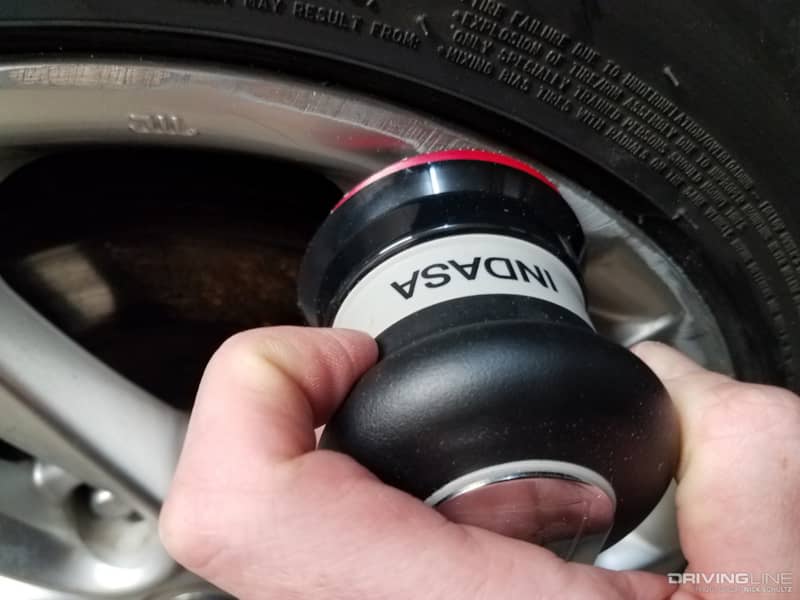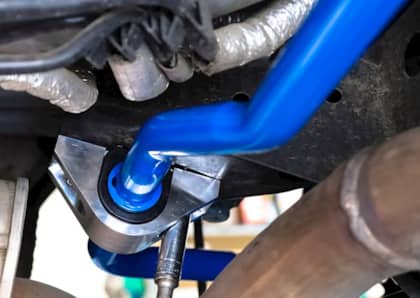Do it Yourself Wheel Repair: Machined-Finish Lip and Spoked Wheels
So you are pulling up to a car show, or dropping a friend off, or getting pulled over and just before you stop—you hear (and feel) the sound of metal grating on concrete. It is an eventuality that happens to everybody— sooner or later a wheel is going to get scuffed, scratched, or scraped. And, it is one of the most gut wrenching things to have happen to a custom ride. The good news is that if the scrape or scuff isn't too deep, and there is no structural damage to the wheel, then you can do the repair yourself, in your own garage. The most important tools required is patience and a delicate touch.
The following tips and tricks work on aluminum and magnesium-alloy wheels.
Scuffed, Machined Lip Wheel Repair
To repair a machined outer lip typically found on Rays/Volk and Forgeline wheels you need a flat file and a round rat tail or needle file, a popsicle stick, 400-800 grit sand paper, masking tape and a small bottle of touch-up clear coat.

Start by masking off the area around the scuff, you don't want to accidentally scratch good areas while you are repairing the bad spot. After making sure the wheel is sound and not bent take the flat file and lightly start reshaping the contour of the lip.

Keep in mind you most likely will not be able to remove or fill in all of the deep scratches but most should smooth over. Then take the round file and shape the cross contours of the lip itself. This is to redefine the peaks and valleys of the machined lip. Both files must be moved in a manner that follows the face of the wheel/surface. Go slowly! Remember, if you take off too much material, you can't add it back.

When most (or all) of the scratches are smoothed over it is time to remove the file marks. This is done by wrapping 320 or 400 grit wet/dry sand paper around a popsicle stick. Doing this makes it easier to control the sand paper and get it into the tight areas of the lip surface. Again, follow the surface of the wheel and make sure to keep the sand paper wet. Keeping the paper wet helps it last longer and lubricates the surface for a better result.

When the file marks are gone switch to 600 and then 800 grit. This will brighten the metal and get it close to a "machined" finish. Note that the higher the grit, the more polished the finish will look. Try to match the finish to the original look. Always move the sand paper in the direction of the wheel surface.

When you are satisfied with the finish (it is very hard to completely eliminate curbing so don't feel discouraged if it isn't perfect), then wipe it clean with a lint free towel and denatured alcohol. Once it is clean, carefully brush the clear coat touch-up over the repaired area. The clear coat seals the alloy and will prevent oxidation—most modern wheels have a clear coat.

Spoke/Lip Wheel Curb Rash Repair
Curb rash on a spoked wheel is a bit easier to fix because the surface is usually simple. The tools needed include a flat file, a small DA (3") or a sanding block, 200-600 grit wet/dry sand paper, primer, paint and clear coat.

If there are deep gouges and ridges, then a flat file is required to smooth things over. Then take a small DA sander such as an Indasa 3" with 200-600 grit disks and lightly/slowly work out the remainder of the scratches. If a DA is not available then use a small foam sanding block. Feather the sanding out to the surrounding area, this will help with blending later.

With sanding complete wipe the area down with a lint free towel and denatured alcohol. Take some metal etching primer and lightly spray the sanded area. If there are sanding scratches still present then wetsand the primer back to metal and repeat the primer step. Repeat until smooth. Color coat the affected area within the recoat time noted on the primer and paint cans. Then clear coat. Make sure to stay within the same brand and paint type for all steps. Duplicolor makes a good wheel paint kit that includes the primer, color coat and clear.

More Wheel Restoration Tips and Tricks
If the whole wheel is painted (black, silver, etc) then body filler can be used to fill in some of the deeper scratches. Fill the scratches prior to priming and painting. Note that body filler cannot be used if the wheel is ever going to get powder coated.

On chromed wheels it is almost impossible to fix scratches yourself. But if the chrome is wet/painted chrome (black base coat of paint with the silver over it) then light scratch repair is possible. Keep the filing and sanding localized and minimal and fill in anything deep with filler. Brush, not spray, black primer onto the scratches. Then take a DecoColor Premium Chrome oil-based paint marker (found at most hobby and art stores) and dab it onto the black primer. The DecoColor markers are about as close to chrome as you can find for a DIY paint touch up.
If the wheels are really scratched and have deep gouges or dents then there are companies that specialize in wheel repair. These shops can even fix wheels that are out-of-round. Of course these types of repairs come at a price, but it is usually cheaper than replacing the wheel.
Restoring your vehicle? Click here for some tips on repainting interior pieces.











